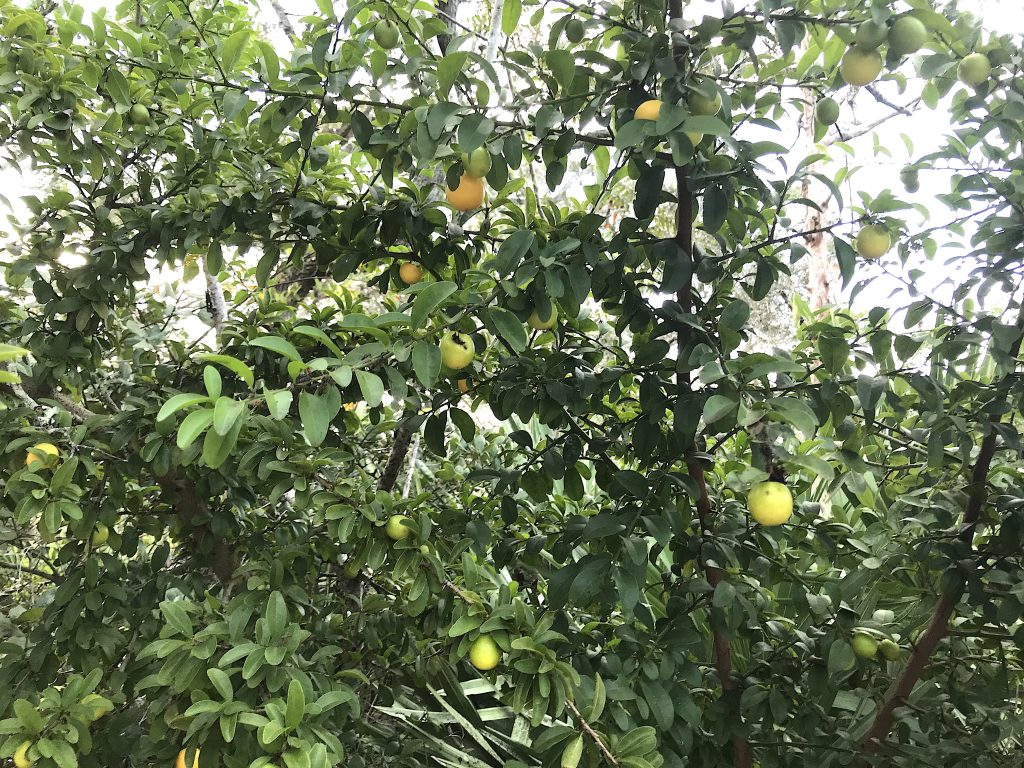
Tallow Plums have been mentioned in recent newsletter. They are still fruiting. This shrub was in Melbourne. To learn more about the Tallow Plum go here. Photo by Green Deane
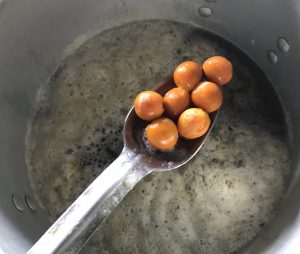
Cooking Queen Palm fruit for wine. Photo by Green Deane
It is said that Pindo Palms favor fruiting in the spring and Queen Palms in the fall though I think I have found both in a variety of times of the year. In fact I started a batch of Pindo Palm wine just a month ago. Yesterday I saw two Queen Palms fruiting so I picked up all the ripe fruit. I got 20 pounds in total which is enough for four gallons of wine. While quite different the two palm species can cross breed. Both are feather palms, the Queen tall and skinny, the Pindo short and squat. The Queen produces deep orange ripe fruit, the Pindo deep yellow ripe fruit. Neither has a lot of pulp but the Pindo has more than the Queen. Their flavors differ as well; the Pindo is fruity the Queen is gooey sweet. Although the Pindo Palm is called the Jelly Palm because of its high pectin content the Queen Palm actually has more pectin. This means it takes longer for the wine to clear, if ever. We’ll see how this batch turns out in a year. (By the way I have a Facebook page called Florida Wine Beer and Bread. It’s all about fermenting including lacto-fermentation which is better known as pickling.)
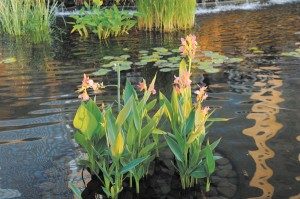
Canna can grow in a garden or a pond.
When it comes to plants you can see something for a long time but not see it. That was my experience with Canna. In the late 80’s a friend of mine had Canna planted along her house. As she was from Taiwan I presumed — like most of the plants around her home — they were native to Asia. As it turned out I was just one in a very long line of people thinking this native of the Americas was actually Asian. I didn’t make the connection to local Canna because the two species have different blossoms, one skinny and red, the other fat and yellow. But then one day while fishing along the St. Johns River east of Sanford I saw a large stand of “native” Canna and investigated. There are several edible parts to the Canna including the roots. The hard seeds, however, have been used as a substitute for buckshot… they are that hard. You can read more about this peripatetic beauty here.
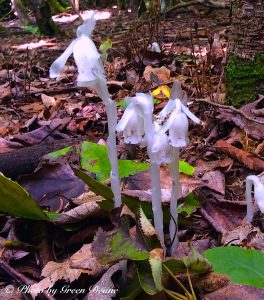
For small plants Indian Pipes get noticed often. Photo by Green Deane
Several plants were called “Indian Pipes” where and when I was growing up. One of them is the Monotropa uniflora. Living more like a mushroom than a plant it sprouts up in various edibility conversations. It helps focus the issue on exactly what “edibility” means. Other than allergies, edibility does imply it will not kill you or harm you in any significant way. But “edibility” does not have to imply tasty. As forager Dick Deuerling used to say “there are a lot of edible plants. I only eat the good stuff.” There are also things that are just too woody or bitter to eat more than a sample of but are included in “edible.” And some plants have to be prepared correctly to be “edible.” Is the Monotropa uniflora edible? Yes. Does it taste good? Only if you’re really hungry. But that is understandable. The list of edible plants has to include everything from incredibly delicious food to only-if-I-were-starving food. Indian Pipes are closer to the famine food end of that list. You can read more about the Monotropa here.

Classes are held rain or shine.
Foraging Classes: Big tropical storms should hold off for another weekend so I’m chancing a class in southeast Florida Sunday in West Palm Beach. Saturday’s class will be in east Orlando at Blanchard Park.
Saturday September 12th, Blanchard Park, 10501 Jay Blanchard Trail, Orlando, FL., 9 a.m. to noon. Meet at the pavilion between the tennis courts and the YMCA building.
Sunday September 13th, Dreher Park, 1200 Southern Blvd., West Palm Beach, FL., 9 a.m. to noon. Meet just north of the science center near the parking lot. 9 a.m. to noon.
Saturday September 19th, Boulware Springs Park, 3420 SE 15th St., Gainesville, FL 32641. 9 a.m. to noon. Meet at the picnic tables next to the pump house. (There may not be any bathrooms at this location now so plan accordingly.)
Sunday September 20th, Spruce Creek Park, 6250 Ridgewood Ave. Port Orange, 32127. 9 a.m. to noon. Meet at the Pavilion. This is one of two class locations in which we can see native Goji Berries.
For more information, to pre-pay for a class, or to sign up go here.
In the olden BC days... before computers… Labor Day meant you went back to school the next day. School also let out sometime in June. Your release date was never exact because several “snow days” were built into the calendar every year. If they weren’t used up we got out in early June. If it was a bad winter then we got out mid-June. We also were not too far removed from harvest time on both ends of the school year.
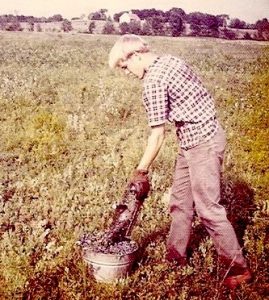
Harold Grandholm, a high school classmate, raking blueberries off the road I grew up on during “summer vacation.”
I walked to school daily, five miles round trip, and that was my preference. The wander took me past blueberry fields, Concord grape hedgerows, apple orchards and a great view of New Hampshire’s Mt. Washington some 60 miles away. I was scrumping every morning and afternoon for six weeks or so. This daily Too & Fro also included crossing the Royal River which was really more of a serf stream except during the spring floods. (Fished and fell into the Royal a lot. Found my first black pearl there and caught my first eel there.) All that wild fall fruit always ruined my supper but then again my mother was a horrible cook so it worked out well. In September and October you also sized up last year’s now dry wood. We had two wood stoves. And once there was snow that meant “pulping” which is cutting next year’s firewood so it can “season” for a year. Plants were also part of school letting out in spring. I noticed way back in sixth grade that when the (edible) Lilacs blossomed school was nearly out for the summer… and summer vacations were wrongly named: For most kids where I grew up it meant farm work until school started in September. For me it was three full months of working in the hay fields, a hot, dusty, hornet-punctuated job. My mother collected horses (and other farm animals) and they had to be fed so into the fields I went, indentured labor. There was also summer gardening, 70 days of it. I only escaped all that by volunteering for the Army in 1969 when Vietnam was hot… young men can make stupid decisions… but I never hayed again.

Green Deane videos are now available on a USB.
Changing foraging videos: My nine-DVD set of 135 videos has been selling for seven years and are still available. They are the same videos I have on You Tube. Some people like to have a separate copy. A second option is a16-gig USB that has those 135 videos plus 15 more. While the videos can be run from the DVDs the videos on the USB have to be copied to your computer to play. They are MP4 files. The150-video USB is $99 and the 135-video DVD set is now $99. The DVDs will be sold until they run out then will be exclusively replaced by the USB. This is a change I’ve been trying to make for several years. So if you have been wanting the 135-video DVD set order it now as the price is reduced and the supply limited. Or you can order the USB. My headache is getting my WordPress Order page changed to reflect these changes. We’ve been working on it for several weeks. However, if you want to order now either the USB or the DVD set make a $99 “donation” using the link at the bottom of this page or here. That order form provides me with your address, the amount — $99 — tells me it is not a donation and in the note say if you want the DVD set or the USB.

Green Deane Forum
Want to identify a plant? Perhaps you’re looking for a foraging reference? You might have a UFO, an Unidentified Flowering Object, you want identified. On the Green Deane Forum we — including Green Deane and others from around the world — chat about foraging all year. And it’s not just about warm-weather plants or just North American flora. Many nations share common weeds so there’s a lot to talk. There’s also more than weeds. The reference section has information for foraging around the world. There are also articles on food preservation, and forgotten skills from making bows to fermenting food.
This is weekly newsletter #422, If you want to subscribe to this free newsletter you can find the sign-up form in the menu at the top of the page.
To donate to the Green Deane Newsletter click here.


The comments you made about the crossing of the Pindo and Queen seems very plausible. I am not sure of which I am using and I collect them from different trees, but there is a difference in the pectin in what I collect even though the fruit are large and squatty as opposed to smaller and football shaped fruit. I do not collect the football shaped one because they do not taste that good. And it seems the seeds are about the size just less meat on the football shaped one. This year I had some jelly that set (might take a up to a week) and some that was used as syrup on pancakes last week that was a month old and never set. I started adding more pectin to the batches and it worked well without making it rock hard. I add red pepper flakes to the batch often and that is good with soft cheese (cream or chevre) or as a glaze for pork and I like a loose set for that product.
The trees I harvest from are not that tall, but i do not know when they were planted but at least 10 years ago. I collect the fruit by cutting the fruit stalk once berries start to drop. I let them ripen in a box at the house. I can cut the fruit stalk off from the ground on all but one of them. It does not matter is the scheme of things, but I would like to know which I am collecting from. They do start producing in June here in the middle of the panhandle of FL. And there was one of the football shaped fruits that had a stalk on it yesterday (9/9/20). I did not see any more stalks on any of the trees.